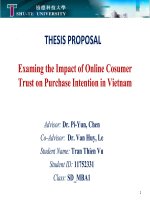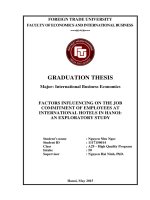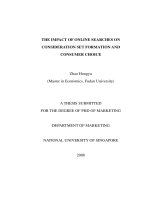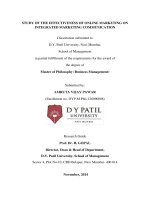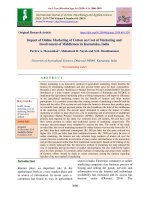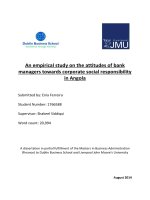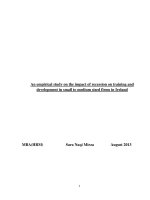the impact of tiktok platform on purchasing intention of generation z in hanoi an empirical study of online marketing via tiktok
Bạn đang xem bản rút gọn của tài liệu. Xem và tải ngay bản đầy đủ của tài liệu tại đây (913.41 KB, 37 trang )
<span class="text_page_counter">Trang 1</span><div class="page_container" data-page="1">
<b>Research Report - Module 301 </b>
<b>THE IMPACT OF TIKTOK PLATFORM ON PURCHASING INTENTION OF GENERATION Z IN HANOI: AN EMPIRICAL STUDY OF ONLINE MARKETING VIA TIKTOK </b>
</div><span class="text_page_counter">Trang 2</span><div class="page_container" data-page="2">2
Table of Contents
1.4.5. Social interaction (INT) ... 13
<b>1.5. Construct and measurement </b>... 13
<b>1.5.1. Instruments for measuring ... </b>13
<b>1.5.2. Variables and Indicators ... </b>14
<b>1.6. Limitation of the research ... </b>15
<b>1.7. Research implementation plan ... 15 </b>
<b>2. Description of the field research </b>... 17
<b>3.4. Time using on TikTok platform of respondents ... </b>21
<b>3.5. Descriptive analysis of Independent variables ... </b>22
<b>3.6. Descriptive analysis of Dependent variables ... </b>28
<b>4. Projections about master thesis ... </b>31
<b>4.1. Reliability analysis ... </b>31
<b>4.2. Regression analysis ... 31 </b>
</div><span class="text_page_counter">Trang 3</span><div class="page_container" data-page="3">3
<b>Table ... 32 5. References ... 33 6. Appendix ... </b>35
</div><span class="text_page_counter">Trang 4</span><div class="page_container" data-page="4">4 Table 1.1. Variables and Indicators ... 14Table 1.2. Research report time schedule ... 16
</div><span class="text_page_counter">Trang 5</span><div class="page_container" data-page="5">5
Figure 1. Research Model1. ... 13
Figure 3.1. Gender of Respondents ... 19
Figure 3.2. Age of respondents ... 20
Figure 3.3. Inome of Respondents ... 21
Figure 3.4. Time spending on TikTok of Respondents ... 22
</div><span class="text_page_counter">Trang 6</span><div class="page_container" data-page="6">6 Gen Z Generation Z
</div><span class="text_page_counter">Trang 7</span><div class="page_container" data-page="7">7
<b>1.1. Background of Research 1.1.1. Overview of TikTok </b>
Social media platforms have revolutionized the way in which people interact with one another, consume media, and make purchasing decisions. As one of the fastest-growing social media platforms in recent years, TikTok has emerged as a powerful tool for businesses to reach and engage with younger audiences. With over 1 billion monthly active users and a vast library of short-form videos, TikTok offers a unique opportunity for marketers to showcase their products and services in creative ways that resonate with younger consumers.
TikTok is a social media platform that has gained widespread popularity since its launch in 2016. Despite its relatively short history, there is growing interest in the app among researchers, as it represents a new era of social media, where creativity and authenticity are valued above all else. One area of research focuses on TikTok's algorithmic approach to content delivery. The app's algorithm is designed to show users content that is relevant to their interests, based on their viewing history and interactions on the platform. Studies have found that this personalized approach to content delivery has contributed to the app's success, as it allows users to discover new content creators and trends. However, concerns have been raised about the potential for users to be exposed to harmful content, such as misinformation or extremist views. Another area of research has focused on the impact of TikTok on mental health and well-being. While some studies suggest that social media use can have negative effects on mental health, others have found that TikTok can be a positive force for s -expression and connection. For example, one study found that TikTok use elfwas associated with higher levels of self-esteem and a greater sense of social connectedness. Other studies have highlighted the potential for TikTok to be used as a tool for mental health interventions, such as through the use of creative expression and peer support. There has also been research on the role of TikTok in shaping cultural trends. TikTok has been credited with popularizing a range of trends, from dance challenges to fashion and beauty trends. Some researchers have argued that TikTok represents a new era of social media, where users are empowered to create and shape popular culture. However, concerns have been raised about the potential for TikTok to contribute to cultural appropriation and the commodification of culture. In addition to these areas of research, there has also been growing interest in the impact of TikTok on privacy and data security. TikTok's ownership by a Chinese company has raised concerns about the potential for user data to be shared with the Chinese government, and there have been calls for greater regulation of the app to ensure user privacy. Overall, the existing literature on TikTok provides valuable insights into the app's unique features and its impact on users and society. However, further research is needed to fully understand the implications of this rapidly growing platform. As TikTok continues to evolve and
</div><span class="text_page_counter">Trang 8</span><div class="page_container" data-page="8">8 shape the social media landscape, it will be important for researchers to stay up- -date on the latest todevelopments and trends to ensure a comprehensive understanding of the platform and its impact.
1.1.2. Statement of problems
In recent years, social media has become an essential tool for marketing and advertising. Social networking sites (SNS) such as Facebook, Instagram, and Twitter have been used by companies to promote their products and services to a wider audience. However, more recently, short-form video platforms like TikTok have become increasingly popular for businesses to engage with their target audience.
In Vietnam, SNS advertisements have been utilized to promote not only big corporations but also small and medium enterprises. This trend has seen a rise in the use of short videos, only 15 seconds long, on TikTok. These videos have been used to showcase products, services, and even company culture in a more entertaining and engaging way.
However, in Hanoi, the capital city of Vietnam, there have been concerns about the harmfulness of social media, particularly the negative impact of short TikTok videos on people. Despite this, I believe that social media, specifically the TikTok platform, has a big impact on the economy. In fact, according to a recent report, TikTok has more than 1.2 million active users in Vietnam, with Generation Z (Gen Z) making up a significant portion of this demographic.
Therefore, I have chosen the topic "The Impact of TikTok Videos on the Purchasing Intention of Generation Z in Hanoi" for my research. I aim to investigate how TikTok videos can influence the purchasing behavior of Generation Z in Hanoi and how companies can leverage this platform to promote their products and services effectively.
In conclusion, while there are concerns about the harmfulness of social media, especially form videos on TikTok, there is no denying the significant impact it has on the economy. As a researcher, I am excited to explore how businesses can utilize this platform to connect with their target audience and achieve their marketing goals.
<b>short-1.2. Research questions and objectives </b>
The rise of social media platforms, particularly TikTok, has drastically changed the landscape of digital marketing. With a large and engaged user base, TikTok has become an essential tool for businesses to reach younger audiences and drive sales. As a marketing student, I am particularly interested in exploring how online marketing strategies can be used to influence consumer behavior, especially among the Gen Z population, which is a crucial demographic for many businesses. Moreover, while there have been studies on the impact of social media on consumer behavior, there is a limited amount of research specifically focused on TikTok, particularly in Vietnam. Given that
</div><span class="text_page_counter">Trang 9</span><div class="page_container" data-page="9">9 TikTok has rapidly gained popularity in Hanoi, it is crucial to understand the effectiveness of online marketing strategies via TikTok to engage with and influence Gen Z consumers' purchasing intentions.
Therefore, the purpose of this study is to fill this research gap by examining the relationship between TikTok videos and the purchasing intention of Gen Z in Hanoi. The findings of this study can provide valuable insights into the effectiveness of online marketing via TikTok, helping businesses to develop better marketing strategies that are tailored to the preferences and values of Gen Z consumers.
<b>Research question</b>: How does TikTok have influence on purchasing intention of Generation Z in Hanoi?
intention.
These research objectives are directly related to the research questions and hypotheses, and they will guide the data collection, analysis, and interpretation. By achieving these objectives, people can gain a better understanding of how TikTok videos can influence Gen Z's purchasing intention in Hanoi, and provide insights for businesses to improve their marketing strategies on this platform.
<b>1.3. Literature Review </b>
<b>1.3.1. Generation Z </b>
Gen Z is the generation born between 1995 and 2010 (Francis & Hoefel, 2018). Gen Z has the features of the “network generation” due to the highly developed digital era in which they were born. They are also described as the “Facebook generation”, “digital natives” or sometimes “iGeneration” (Tari, 2011). Gen Z youth have been brought up in the first truly mobile era (Palley, 2012). The Kaiser Family
</div><span class="text_page_counter">Trang 10</span><div class="page_container" data-page="10">10 Foundation reports that Gen Z youth are exposed to more media than any other activity other than sleeping, with a 67-minute daily increase in the number of time participants spent for and corresponding to the media in 2009, compared with 2004 (Rideout et al., 2010).
1.3.2. TikTok
TikTok is a famous social media app that lets in customers create, watch, and proportion 15-second movies shot on cell phones. With its customized feeds of quirky brief movies set to song and sound results, the app is first rated for its addictive nice and excessive stages of engagement. Even expert or non-expert content creators can upload different types of videos with filters, songs, stickers, and many other effects to make their videos more attractive (D’souza, 2021).
TikTok is a social media platform that has taken the world by storm in recent years. Launched in China in 2016, the app quickly gained a massive following and has since expanded to become a global sensation. TikTok's success can be attributed to its unique approach to social media, which allows users to create and share short-form videos with a range of features, including music, filters, and effects. The app has become a cultural phenomenon, especially among younger generations, and has given rise to a new wave of content creators who are using the platform to showcase their creativity and connect with like-minded individuals.
One of the key features that sets TikTok apart from other social media platforms is its algorithmic approach to content delivery. The app's algorithm is designed to show users content that is relevant to their interests, based on their viewing history and interactions on the platform. This has made TikTok a powerful tool for discovering new content creators and trends, and has helped to democratize the process of content creation.
However, TikTok's success has also sparked discussions about the impact of social media on society. Critics have raised concerns about privacy and data security, as well as the potential impact of social media on mental health and well-being. In addition, there have been debates about the influence of social media on cultural trends, and the role that platforms like TikTok play in shaping popular culture.
Despite these concerns, TikTok remains one of the most popular social media platforms in the world, with millions of users across the globe. Its success has paved the way for a new generation of content creators and has given rise to a new era of social media, where creativity and authenticity are valued above all else.
1.3.3. Purchasing Intention
Purchase intention refers to a psychological construct that involves a consumer's subjective inclination to purchase a particular product or service based on their past experiences and personal preferences (Keller & Kotler, 2016). This complex process is influenced by various factors,
</div><span class="text_page_counter">Trang 11</span><div class="page_container" data-page="11">11 including the consumer's behavior, perception, and mode. Belch and Belch (2009) suggest that purchase intention is a consumer's inclination or preference to buy a specific brand or take actions related to purchases that are influenced by their likelihood of purchasing a product or service. Generally, consumers tend to make their purchasing decisions after evaluating the product or service. Keller's (2001) research highlights that external factors play a significant role in shaping consumer purchase intentions, including marketing, social influence, and cultural factors. As such, understanding purchase intention is crucial for marketers to develop effective marketing strategies that align with consumer preferences and drive sales.
<b>1.4. Model and Hypothesis </b>
The Theory of Planned Behavior (TPB) is a widely recognized theory that helps to explain the factors that influence individual decision-making. Specifically, TPB explores the influence of individual variables, social circumstances, and non-volitional determinants on the purchase intention of customers (Ajzen, 2020; Han & Kim, 2010). The theory proposes that consumers' buying decisions are influenced by three main aspects: psychological factors, individual traits, and societal factors (Ajzen, 1991).
To investigate consumer behaviors, the ABC theory (Attitude, Behavior, and Context) provides a useful framework. This theory was first introduced by Katz in 1937 and posits that attitudes and behavior are influenced by contextual factors. By considering these factors, researchers can gain a better understanding of the underlying factors that influence purchasing decisions.
In addition to these theoretical frameworks, other research has directly investigated the impact of various variables on purchasing behavior. For example, Cheung et al. (2019), Lee et al. (2015), and Shin et al. (2017) have explored the influence of factors such as product information, prices, external driving factors, and product quality on purchasing behavior. These studies provide valuable insights into the direct impact of these variables on consumer decision-making.
Overall, these theoretical frameworks and previous research provide a foundation for investigating the impact of TikTok videos on Gen Z's purchasing intention in Hanoi. By building on this existing knowledge, the present study aims to provide a more comprehensive understanding of the factors that influence purchasing behavior on TikTok, and to provide insights for businesses seeking to improve their marketing strategies on this platform.
1.4.1. Information (INF)
Informational advertising on TikTok: The information element is the ability to effectively provide information related to the product to be advertised to consumers. When using ads on TikTok,
</div><span class="text_page_counter">Trang 12</span><div class="page_container" data-page="12">12 information is an important factor because customers will find the necessary information about the products they want to buy and use. It’s also critical that the information is accurate, clear, and useful to the consumer. Based on research on customer perceived value and attitude toward advertising (Ducoffe, 1996; Eze & Lee, 2012; Lana & Bẹnamin, 2001; Ling et al., 2010; Petrovici & Marinov, 2005;) information is an important factor in this research, so the authors propose hypothesis H1 as follows:
H1: Information on TikTok has a positive effect on Gen Z purchase intention.
1.4.2. Entertainment (ENT)
Entertainment is the level of emotion brought to the user when viewing an ad. Entertainment in online advertising positively impacts consumers’ perceived values and attitudes (Ducoffe, 1996). A high level of enjoyment and attraction in the process of interacting with the media will positively affect their feelings and moods (Nguyen et al., 2013), indicating entertainment in online advertising has a positive impact on consumers’ perceived value and attitudes, so the authors propose hypothesis H2 as follows:
H2: Entertainment on TikTok has a positive effect on Gen Z purchase intention.
1.4.3. Trust (TRU)
Trust is the user’s level of trust in advertising on TikTok. Advertising credibility refers to the degree of trust consumers have in the advertising message and is based on trust placed in the source of the advertisements and the advertiser (MacKenzie & Lutz, 1989). Trust has been shown to have a direct, positive effect on the attitude towards advertising, brand attitude, and purchase intention of consumers (Goldsmith et al., 2000). Trust is an important factor in this research, so the authors propose hypothesis H3 as follows:
H3: Trust in TikTok has a positive effect on Gen Z purchase intention
1.4.4. Disturbance (DTB)
Marketing activities such as advertising frequently appear distracting, annoying, and offensive to consumers (Ducoffe, 1996). When customers are uncomfortable seeing an advertisement, they underestimate its worth (Brackett & Carr, 2001). The ads that continuously appear with high frequency will cut off the excitement when watching videos, making the audience lose good feelings. Based on research on customer perceived value and attitude (Ducoffe, 1996), advertising orientation; (Lana et al., 2001), study the attitude toward mobile advertising (Haghirian &
</div><span class="text_page_counter">Trang 13</span><div class="page_container" data-page="13">13 Madlberger, 2005; Tsang et al., 2004). Since the disturbance is an important factor affecting the interest of consumers in an advertisement, the authors propose hypothesis H4 as follows: H4: Disturbance on TikTok has a negative effect on Gen Z purchase intention.
1.4.5. Social interaction (INT)
The level of contact between users with advertising types is referred to as social interaction. It is defined as a way for people to effectively connect regardless of location or time (Ngo & Mai, 2017). The researchers discovered that the social interaction variable had a significant impact on online buying intentions in a study on the impact of social network advertising on customers’ purchase intentions (Ngo & Mai, 2017). Therefore, we propose hypothesis H5 as follows:
H5: Social Interaction on TikTok has a positive effect on Gen Z purchase intention. The conceptual framework of this research is demonstrated in Figure 1.
<b>Figure 1.1: Research Model </b>
<b>1.5. Construct and measurement 1.5.1. Instruments for measuring </b>
The construct in this report is the impact of TikTok on the purchasing behavior of Gen Z in Hanoi. This construct is operationalized through the use of 5-point Likert scale questions, which are used to measure the 5 proposed hypotheses. The 5 independent variables identified in this report - information, entertainment, trust, disturbance, and interaction - are each constructs that are being measured in relation to the impact of TikTok on purchasing behavior. These constructs are measured using multiple items within each construct.
</div><span class="text_page_counter">Trang 14</span><div class="page_container" data-page="14">14
<b>Table 1.1. Variables and Indicators </b>
<b>Number Variables Indicators </b>
1 Information • INF1 Timely updated information channel • INF2 Provides necessary and useful information • INF3 Provides more information than other advertising
• TRU2 Advertising via TikTok is reliable • TRU3 More reliable than traditional ads 4 Disturbance • DTB1 TikTok ads are annoying
• DTB2 Content is often annoying, distracting
• DTB3 Feeling annoyed when receiving too many ads with similar content
intent
</div><span class="text_page_counter">Trang 15</span><div class="page_container" data-page="15">15 • PI4 The richer the advertising content on TikTok, the
higher the purchase intention
<b>1.6. Limitation of the research </b>
While this study provides useful insights into the impact of TikTok videos on the purchasing intention of the young generation in Hanoi, several limitations were encountered. One of these limitations is the study's specific geographic focus on Hanoi and its concentration on the young generation's purchasing intention through TikTok. Hence, the generalizability of the findings to other regions and age groups should be treated with caution. To address this limitation, future research could expand its scope to other regions and age groups to enhance the study's external validity.
Moreover, this study used a quantitative research method, which may have limited the depth and complexity of participants' experiences and perceptions. Thus, future research could use qualitative research methods such as interviews or focus groups to capture a more comprehensive understanding of the phenomenon under investigation. This approach would provide a more detailed view of the participants' perspectives and experiences.
Lastly, this study did not examine the long-term effects of TikTok videos on purchasing behavior, which could be a fascinating direction for future research. Examining the long-term effects of TikTok videos on purchasing behavior could provide insights into the sustainability and durability of TikTok's impact on purchasing decisions. It would also help identify whether TikTok's impact on purchasing behavior is temporary or permanent.
In conclusion, although this study encountered several limitations, it provides valuable insights into the impact of TikTok videos on the purchasing intention of the young generation in Hanoi. It can serve as a foundation for future research in this area, and addressing the limitations could help further enhance our understanding of the effects of TikTok videos on purchasing behavior.
<b>1.7. Research implementation plan </b>
The research process consists of four crucial stages, each requiring careful planning and execution. The first stage involves selecting the research topic and developing a research proposal, which lays out the scope and objectives of the study. The second stage involves collecting data through a research survey that will be administered to the passengers. This stage requires proper planning and organization to ensure that the data collected is valid, reliable, and representative of the target
</div><span class="text_page_counter">Trang 16</span><div class="page_container" data-page="16">16 population. The third stage involves analyzing the collected data and producing a comprehensive research report that outlines the findings and their implications. This stage requires careful attention to detail and a thorough understanding of the data analysis techniques used to ensure accurate and reliable results. Finally, the fourth stage involves finalizing the research report and submitting it for review. Table 2 provides a detailed timeline of the research plan, which outlines the key 1.milestones and deadlines for each stage of the research process. By adhering to this timeline, the researchers can ensure that the research is conducted efficiently and effectively, and that the results are produced in a timely manner.
<b>Table 2.Research report time schedule1.</b>
<b>No Activities Time Schedule </b>
<b>Dec22 Jan23 Feb23 Mar23 Apr23 </b>
1 Chang the topic
questionnaire 3 Data collection 4 Data input an
analysis 5 Writing report 6 Final submission
</div><span class="text_page_counter">Trang 17</span><div class="page_container" data-page="17">17
<b>2.1. Sample size </b>
Exploratory factor analysis (EFA) is a statistical technique that aims to identify underlying factors or dimensions that explain the relationships among a set of observed variables. To ensure the accuracy and reliability of the results, it is important to have a sufficient sample size. According to Hair et al. (1998), a sample size of at least five times the number of observed variables is recommended for EFA. For instance, if a study involves 20 observed variables, the sample size should be at least 100 participants. In addition, Gorsuch (1983) suggests a minimum sample size of 200 for studies that employ EFA.
In this study, there are 23 observed variables on the official scale for EFA. Therefore, the minimum sample size required is 23 * 5 = 115 participants, based on the recommendation by Hair et al. (1998). However, to increase the validity and credibility of the study, the research aim to collect data from a larger sample of 250 participants. By doing so, the study can ensure a sufficient sample size for the EFA and obtain more robust and generalizable results. It is important to note that a larger sample size can also help to increase the statistical power of the study, which means that the study is more likely to detect significant effects or relationships among the variables.
Furthermore, it is important to consider other factors that may affect the sample size calculation. For instance, the complexity of the data, the variability of the variables, and the level of desired precision may also influence the sample size. Therefore, it is recommended to consult with a statistician or use a sample size calculator to determine the appropriate sample size for the specific research question and design.
<b>2.2. Sampling method </b>
The goal of sampling is to minimize error and maximize representation without increasing costs and time. There are various methods for sampling, and the appropriate method should be applied depending on the purpose and conditions. In this study, the data was collected using the "convenience sampling" method or "opportunity sampling" via a survey. Questionnaires were created and uploaded on Google Forms, then distributed to participants via the internet. The response rate was 95%. The study included people who belong to Generation Z (born between 2010 and 1995) and reside in Hanoi, Vietnam. The questionnaire was designed based on multiple-item measurement scales for videos on the TikTok platform, and the measurements were measured on a 5-point Likert-type scale. The questionnaire consists of main variables such as information on TikTok, entertainment, trust, disturbance, social interaction, purchasing intention, and the profile of respondents.
</div><span class="text_page_counter">Trang 18</span><div class="page_container" data-page="18">18 The data collected through the convenience sampling method may not adequately represent the entire population of Generation Z in Hanoi, Vietnam. This is because the sample population may not be representative of the whole population. It is important to note that the response rate of the survey was high, which increases the reliability of the study results. Overall, the study provides valuable insights into the attitudes and behaviours of Generation Z in Hanoi towards TikTok. The study's findings in regard to the variables of information on TikTok, entertainment, trust, disturbance, social interaction, and purchasing intention could provide useful information for businesses that are interested in marketing on TikTok. For instance, understanding the variables that influence purchasing intention that Generation Z in Hanoi have towards TikTok can allow businesses to tailor their marketing strategies to be more effective in reaching out to this demographic. The study's findings on the variables of trust and disturbance could also provide insights into how TikTok's platform can be improved to better cater to the needs and wants of its users.
Although the study's results are not generalizable to the entire population of Generation Z in Hanoi, it can still be used as a starting point for future studies to explore further into the topic. Future studies could apply different sampling methods to increase the generalizability of the results.
<b>2.3. Data Analysis </b>
SPSS computer software has been used to analyze the data collected through the survey. The program has been used to analyze relationships between variables to confirm hypothesis proposed in this research. Using SPSS allows for statistical analysis to be conducted accurately and efficiently. This ensures that the study's results are reliable and valid.
The use of SPSS to analyze the data also makes it easier to identify patterns and relationships between variables. This can help to uncover insights that may not have been apparent otherwise. Additionally, using SPSS allows for the results to be presented in a clear and concise manner, which makes it easier for readers to understand the findings. The use of SPSS in this study is an important component in ensuring the reliability and validity of the study's results.
</div>